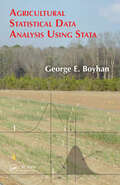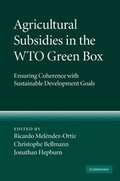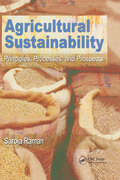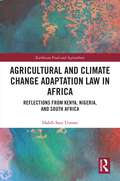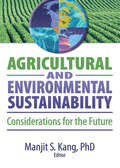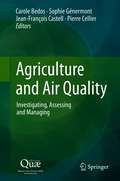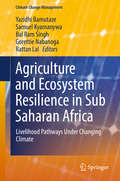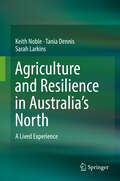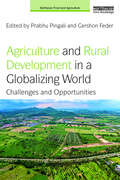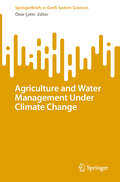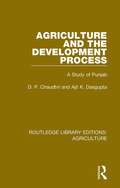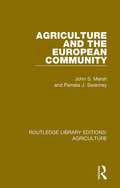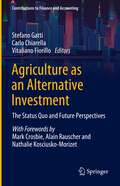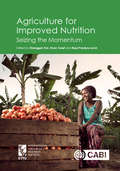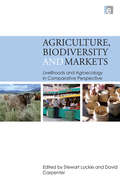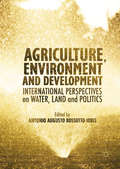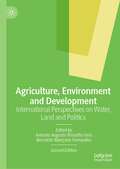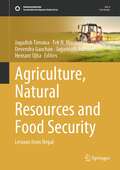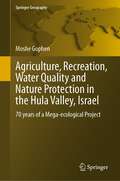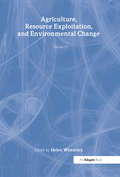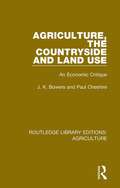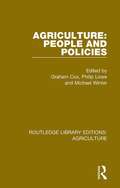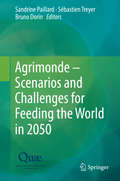- Table View
- List View
Agricultural Statistical Data Analysis Using Stata
by George BoyhanPractical statistics is a powerful tool used frequently by agricultural researchers and graduate students involved in investigating experimental design and analysis. One of the most widely used statistical analysis software packages for this purpose is Stata. The Stata software program has matured into a user-friendly environment with a wide variet
Agricultural Subsidies in the WTO Green Box: Ensuring Coherence with Sustainable Development Goals
by Ricardo Meléndez-Ortiz Christophe Bellmann Jonathan HepburnDo the World Trade Organization's rules on 'green box' farm subsidies allow both rich and poor countries to achieve important goals such as food security, or do they worsen poverty, distort trade and harm the environment? Current WTO requirements set no ceiling on the amount of green box subsidies that governments can provide, on the basis that these payments cause only minimal trade distortion. Governments are thus increasingly shifting their subsidy spending into this category, as they come under pressure to reduce subsidies that are more directly linked to production. However, growing evidence nonetheless suggests that green box payments can affect production and trade, harm farmers in developing countries and cause environmental damage. By bringing together new research and critical thinking, this book examines the relationship between green box subsidies and the achievement of sustainable development goals, and explores options for future reform.
Agricultural Sustainability: Principles, Processes, and Prospects
by Saroja RamanTake a balanced look at ways to ensure food security and to work to erase hunger around the worldAgriculture is the most aggressively managed ecosystem. Agricultural Sustainability: Principles, Processes, and Prospects provides a comprehensive examination of all facets of agricultural sustainability, beginning with the history of the evolution of the concept to the present. Challenges to sustainability are clearly presented along with practical strategies to counter prospective problems. This vital resource considers options for the future, as well as reviewing past approaches for their value in today’s world.When one considers that the alternative to agricultural sustainability is the collapse of the world’s food systems, it is understood that compromise is impossible. Agricultural Sustainability takes a holistic approach to the issues that are involved in making agriculture ecologically sound, economically viable, and socially responsible around the world. The book is divided into three parts. Part One clarifies the concept of agricultural sustainability, bringing a rational and balanced view of the core elements. Part Two discusses ways to promote sustainability in the world, including practical scientific and technological processes for improving yields while ensuring food security for future generations. Part Three peers into future decades, reviewing the vision documents of international agencies, their perceptions and expectations for the years ahead, and present dysfunctional aspects in the current food system. The book is extensively referenced and includes figures and charts to clearly explain data.The book examines: the historic evolution of the concept of agricultural sustainability the combined effects of a multiplicity of agricultural systems concepts for validating the sustainability of a production system the role of natural capital in production the role of science and technology in sustainable use managing land, water, biodiversity, and energy quantitative approaches to measuring agricultural sustainability the current status of agricultureand predictions for its growth in the coming decades case studies of agricultural growth from India and China problemsand possibilitiesof creating a hunger-free world by the end of this century Agricultural Sustainability is crucial, enlightening reading for field workers in NGOs and agricultural extensions; personnel in local, national, and international developmental organizations; and educators and students of sustainable agricultural production, food security, rural development, environmental science, and the conservation of natural resources.
Agricultural Water Management: Proceedings of a Workshop in Tunisia
by National Research Council of the National AcademiesThis report contains a collection of papers from a workshop---Strengthening Science-Based Decision-Making for Sustainable Management of Scarce Water Resources for Agricultural Production, held in Tunisia. Participants, including scientists, decision makers, representatives of non-profit organizations, and a farmer, came from the United States and several countries in North Africa and the Middle East. The papers examined constraints to agricultural production as it relates to water scarcity; focusing on 1) the state of the science regarding water management for agricultural purposes in the Middle East and North Africa 2) how science can be applied to better manage existing water supplies to optimize the domestic production of food and fiber. The cross-cutting themes of the workshop were the elements or principles of science-based decision making, the role of the scientific community in ensuring that science is an integral part of the decision making process, and ways to improve communications between scientists and decision makers.
Agricultural and Climate Change Adaptation Law in Africa: Reflections from Kenya, Nigeria, and South Africa (Earthscan Food and Agriculture)
by Habib Sani UsmanThis book presents an analysis of climate change and agricultural laws in Kenya, Nigeria, and South Africa in order to determine whether they adequately addressed the concept of agricultural adaptation.Agriculture is one of the sectors of the economy that is contributing to climate change, and at the same time the sector is heavily impacted by climate change. Therefore agricultural adaptation is required. Focusing on three countries, this book provides a novel, comparative examination of how and to what extent the law promotes agriculture-focused adaptation in these countries. The role of the law in addressing issues such as water management strategies, soil conservation methods, and crop production methods is discussed. This book identifies gaps in the regulatory frameworks for agricultural adaptation and highlights the lack of adaptive capacity of African agriculture due to weak or non-existing legal frameworks. It discusses ways to remedy these gaps through specific on-farm adaptation strategies, legislative amendments to consolidate all relevant national climate change-related policies and laws with agricultural policies and laws that have relevant provisions on adaptation as medium-term solutions, and the development of a specific framework law for agriculture-focused adaptation, incorporating essential agricultural adaptation strategies, could perhaps be enacted as long-term solutions to the regulatory gaps.This book will be of great interest to students and scholars of law, climate change, food and agriculture, sustainable development, and African studies.
Agricultural and Environmental Sustainability: Considerations for the Future
by Manjit S. KangUnderstand sustainable development from economic, ecological, and social perspectivesAs world population continues to increase, the need grows for a safe, sustainable supply of food. Agricultural and Environmental Sustainability: Considerations for the Future provides the latest research results and vital information on the process of p
Agriculture Geography First Semester FYBA, B.COM, B.SC New NEP Syllabus - SPPU
by Dr Jyotiram C. More Prof. Harishchandra S. Timbole Dr Ganesh Madhukar DhawaleThe book titled "Agriculture Geography" provides a comprehensive overview of agricultural geography, its principles, and its importance. It begins with the definition and scope of agricultural geography, examining the spatial relationships between agriculture and human activities. The text discusses the various types of agriculture, including subsistence, commercial, and mixed farming, as well as modern trends like smart and natural farming. It explores the physical and economic factors influencing Indian agriculture, highlights the historical and geographical transformations in agricultural practices, and addresses the impact of agricultural revolutions like the Green, White, and Blue Revolutions. The book also covers government policies, technological advancements, and new perspectives aimed at achieving sustainable agriculture, ensuring food security, and improving farmer incomes. Designed as a textbook for students, it combines theoretical knowledge with practical insights, supported by exercises and examples for academic and competitive examinations.
Agriculture and Air Quality: Investigating, Assessing and Managing
by Carole Bedos Sophie Génermont Jean-François Castell Pierre CellierThis book gives an overview of the relationships between agriculture and air quality, which is an issue of increasing importance for practitioners and policy makers. It provides the keys to understand natural and anthropogenic mechanisms governing emission and deposition of pollutants produced by and/or impacting agricultural activitiesIt identifies how management practices can help mitigating emissions and how public policies on air pollution progressively addressed the agricultural sectorThis book was written for students, researchers and agriculture actors as well as for public decision-makers
Agriculture and Ecosystem Resilience in Sub Saharan Africa: Livelihood Pathways Under Changing Climate (Climate Change Management)
by Rattan Lal Bal Ram Singh Yazidhi Bamutaze Samuel Kyamanywa Gorettie NabanogaThis volume discusses emerging contexts of agricultural and ecosystem resilience in Sub Saharan Africa, as well as contemporary technological advances that have influenced African livelihoods. In six sections, the book addresses the sustainable development goals to mitigate the negative impacts on agricultural productivity brought about by climate change in Africa. Some of the challenges assessed include soil degradation, land use changes, natural resource mismanagement, declining crop productivity, and economic stagnation. This book will be of interest to researchers, NGOs, and development organizations.Section 1 focuses on climate risk management in tropical Africa. Section 2 addresses the water-ecosystem-agriculture nexus, and identifies the best strategies for sustainable water use. Section 3 introduces Information Communication Technology (ICT), and how it can be used for ecosystem and human resilience to improve quality of life in communities. Section 4 discusses the science and policies of transformative agriculture, including challenges facing crop production and management. Section 5 addresses landscape processes, human security, and governance of agro-ecosystems. Section 6 concludes the book with chapters uniquely covering the gender dynamics of agricultural, ecosystem, and livelihood resilience.
Agriculture and Resilience in Australia’s North: A Lived Experience
by Keith Noble Tania Dennis Sarah LarkinsThis book examines the mechanisms and strategies farmers in North Australia adopt to manage the setbacks and challenges they face. This social research is based on farmers’ experiences, but also draws on the author’s own experience after his tropical fruit farm was destroyed by two Category 5 cyclones in five years.Through historical analysis, the book compares historic and contemporary aspirations for northern development, and discusses the influence of the built environment on individuals as well as access to health and other social services.Exploring the implications of individual resilience strategies for policy development within the broader context of northern development and evolving environmental governance, the book also highlights the fact that this is occurring in a new geological epoch – the Anthropocene.The book will provide a unique perspective and understanding to government, individuals and industries interested in northern Australia and its relationship to the world
Agriculture and Rural Development in a Globalizing World: Challenges and Opportunities (Earthscan Food and Agriculture)
by Prabhu Pingali; Gershon FederRapid structural transformation and urbanization are transforming agriculture and food production in rural areas across the world. This textbook provides a comprehensive review and assessment of the multi-faceted nature of agriculture and rural development, particularly in the developing world, where the greatest challenges occur. It is designed around five thematic parts: Agricultural Intensification and Technical Change; Political Economy of Agricultural Policies; Community and Rural Institutions; Agriculture, Nutrition, and Health; and Future Relevance of International Institutions. Each chapter presents a detailed but accessible review of the literature on the specific topic and discusses the frontiers in research and institutional changes needed as societies adapt to the transformation processes. All authors are eminent scholars with international reputations, who have been actively engaged in the contemporary debates around agricultural development and rural transformation.
Agriculture and Water Management Under Climate Change (SpringerBriefs in Earth System Sciences)
by Öner ÇetinThis book analyzes how major events such as the recent pandemic crisis, wars around the world and climate change, have affected agricultural production and the direct food supply. In this sense, human nutrition will never be off the agenda. The book provides information and guidelines for both practitioners and decision-makers about important developments in the use of agriculture, soil and water resources for agricultural purposes, including the effective and efficient use of soil and water resources where agricultural production, increasing water productivity, the use of modern technology and digitalization for this purpose. Accordingly, a number of chapters have been prepared by experts in the field, covering a variety of the above-mentioned objectives.
Agriculture and the Development Process: A Study of Punjab (Routledge Library Editions: Agriculture #2)
by Ajit K. Dasgupta D. P. ChaudhriFirst published in 1985. The need to increase agricultural output and to use increased output to generate sustained general economic development is a problem facing many Third World countries. This book explores in particular the agricultural growth of the Punjab in Northern India, a country which has long been a leader in the formulation of new development strategies. It shows how agricultural output is affected by, and affects, demographic changes, income distribution, state involvement and structural changes both in society and the economy. Agricultural growth in the Punjab is seen in an historical perspective. In addition, the different aspects of economic development are viewed in an integrated way so that much is learned about the contribution of agricultural growth to the development process. The conclusions drawn can be related to problems and trends worldwide.
Agriculture and the European Community (Routledge Library Editions: Agriculture #3)
by John S. Marsh Pamela J. SwanneyFirst published in 1980. From the earliest beginnings of the European Economic Community, it was recognised that a common market for agriculture would be one of the basic prerequisites for workable economic unity. And yet the Common Agricultural Policy (CAP) remained a subject of much controversy and debate. The CAP, more than any other element of European policy, was seen to test the true depth of the commitment shown by Community members to the practice as well as the principle of economic integration. Agriculture and the European Community examines the reasons for the existence of the CAP and its format. It outlines the main instruments, price and structural policy, and the changing emphasis between them. It discusses in turn the effects of the CAP on producers’ income levels and on consumer prices; how far it had fulfilled the promises of the Treaty of Rome; the implications of the policy for third country trade; and its place within the Community as a whole. The study argues that, although incomes of Community farmers had improved, this is not simply the result of the CAP, nor was the geographical distribution of benefit in terms of farming income satisfactory. The policy has achieved a degree of success in securing food supplies and stabilising prices but the cost to the consumer has been high. Knowledge of the CAP had become almost essential to any understanding of modern European affairs. Agriculture and the European Community will serve as a straightforward introduction to the policy for students approaching the subject for the first time, especially in departments of Agricultural Economics, European Studies and Political Science.
Agriculture as an Alternative Investment: The Status Quo and Future Perspectives (Contributions to Finance and Accounting)
by Stefano Gatti Carlo Chiarella Vitaliano FiorilloUnder the pressure of climate and social changes, agriculture is called to play a fundamental role in the world food challenge of the next few decades. A severe reduction of arable land and water scarcity combined with a growing food demand, changes in the dietary preferences in many countries and, more recently, a growing threat to food security and logistics from supply chains interruptions and global trade fragmentation, all require the implementation of processes, techniques, and innovations able to increase productivity and make a better use of scarce resources.Against this backdrop, a growing number of investors and asset managers have started looking at agriculture as an interesting investment theme to exploit the long-term strategic opportunities emerging from technological innovation and social changes. The industry is undergoing a process of transformation driven, on the one hand, by the emergence of new data and technologies that promise enhancing process efficiency and improve yields and, on the other hand, by an increased attention on the GHG emissions of agricultural processes and the impact of farmland on climate change, water and land scarcity. All these factors call for a radical rethinking of many agriculture business models. This book provides a detailed overview and analysis of those new technologies with the greatest potential to disrupt agriculture products and processes by improving productivity and the management of food loss and waste, making a more efficient and sustainable use of resources and enhancing food security. Then, it discusses the implications for investors and asset managers, starting with an assessment of the status quo of agriculture investing and providing a thorough description of the agriculture asset class with an emphasis on its distinctive characteristics and the innovations in the technological processes used in agriculture and farming with the greatest potential to obtain long-term sustainable returns.
Agriculture for Improved Nutrition: Seizing the Momentum
by Stuart Gillespie Amy Saltzman Kevin Chen Lawrence Haddad Mathew Abraham Prabhu L Pingali Nicholas Nisbett Suresh Chandra Babu Noora-Lisa Aberman Akhter U. Ahmed Summer Allen Ekin Birol Anne Bossuyt Howarth E. Bouis Gerald F. Jr Olivier Ecker Dr Jessica Fanzo Aulo Gelli Julie Ghostlaw Daniel O. Gilligan Derek Headey Mar Maestre Hazel Malapit William Masters Ruthie Musker Rajul Pandya-Lorch Daniel J. Raiten Marie T. Ruel Zimeiyi Wang Sivan YosefAgriculture's vast potential to improve nutrition is just beginning to be tapped. New ideas, research, and initiatives developed over the past decade have created an opportunity for reimagining and redesigning agricultural and food systems for the benefit of nutrition. To support this transformation, this book reviews the latest findings, results from on-the-ground programs and interventions, and recent policy experiences from countries around the world that are bringing the agriculture and nutrition sectors closer together. Drawing on IFPRI's own work and that of the growing agriculture-nutrition community, this book strengthens the evidence base for, and expands our vision of, how agriculture can contribute to nutrition. Chapters cover an array of issues that link agriculture and nutrition, including food value chains, nutrition-sensitive programs and policies, government policies, and private sector investments. By highlighting both achievements and setbacks, Agriculture for Improved Nutrition seeks to inspire those who want to scale up successes that can transform food systems and improve the nutrition of billions of people. Key features: -Investigates the latest evidence on the relationship between agriculture and nutrition. -Includes insights from internationally renowned researchers. -Presents data from real-world settings that is highly relevant to the challenges faced by developing countries. This book is ideal for policy-makers, practitioners, and students working in agriculture, international development and nutrition.
Agriculture, Biodiversity and Markets: Livelihoods and Agroecology in Comparative Perspective
by Stewart Lockie David CarpenterDebate about how best to ensure the preservation of agricultural biodiversity is caught in a counter-productive polemic between proponents and critics of market-based instruments and agricultural modernisation. This book argues that neither position does justice to the range of strategies that farmers use to manage agrobiodiversity and other livelihood assets as they adapt to changing social, economic, and environmental circumstances. Chapters explore relationships between the exploitation and conservation of agricultural biodiversity and the livelihoods of agricultural communities, and evaluate the capacity of national and multilateral institutions and policy settings to support the protection and capture by communities of agrobiodiversity values. The place of ecosystem services in valuing biodiversity in the marketplace is emphasized. A number of authors assess the potential for market-based instruments and initiatives to encourage the protection of biodiversity, while others compare agrobiodiversity/community relationships, and the effectiveness of instruments designed to enhance these, across international boundaries. The book takes a comparative approach, drawing on empirical case studies from across the developed and developing worlds. In doing so, the book does not simply point to similarities and differences in the experience of rural communities. It also shows how global trade and multilateral institutions bring these otherwise disparate communities together in networks that exploit and/or preserve agrobiodiversity and other resources.
Agriculture, Environment and Development: International Perspectives on Water, Land and Politics
by Antonio A.R IorisThis book deals with past legacies and emerging challenges associated with agriculture production, water and environmental management, and local and national development. It offers a critical interpretation of the tensions associated with the failures of mainstream regulatory regimes and the impacts of global agri-food chains. The various chapters include conceptual and empirical material from research carried out in Brazil, India and Europe. The assessment takes into account the dilemmas faced by farmers, companies, policy-makers and the international community related to growing food demand, water scarcity and environmental degradation. The book also questions most government reactions to those problems that tend to reproduce old, productivist approaches and are normally under the powerful influence of global corporations, mega-supermarkets and investment funds. Its overall message is that the trajectory of agriculture, rural development and environmental management are integral elements of the broader search for justice and novel socio-ecological thinking.
Agriculture, Environment and Development: International Perspectives on Water, Land and Politics
by Antonio Augusto Rossotto Ioris Bernardo Mançano FernandesThe Second Edition of this book is completely revised and updated throughout providing an overview of current challenges faced within the area of Agri-food in relation to policymaking, ecological conservation and socio-environmental justice. Including a range of new chapters, the book explores some of the conceptual and analytical gaps that are presented by current approaches to this topic. The series of interconnected chapters offers a critical reinterpretation of the tensions associated with the failures of mainstream regulatory regimes, land and resource grabbing, and the impacts of global agri-food chains at local, regional and inter-sectoral scales. The book also examines past legacies and emerging challenges associated with agriculture modernisation, politico-spatial disputes, climate change, social movements, gender, ethnicity and education. It likewise addresses the transformative potential of different combinations of biophysical, socio-technical and socio-spatial practices of food sovereignty.
Agriculture, Natural Resources and Food Security: Lessons from Nepal (Sustainable Development Goals Series)
by Jagadish Timsina Tek N. Maraseni Devendra Gauchan Jagannath Adhikari Hemant OhjaThis book explains how a former net food exporting Nepal has become a net food importing country due to a lack of an integrated system-wide approach to planning and governance of agriculture and natural resources. It demonstrates how various components of the food system, such as agronomy, agrobiodiversity, plant health, post-harvest management, livestock and fisheries, and socio-economics including marketing and trade, have been managed in sectoral silos, crippling the very foundations of food systems innovations. The book also explores ways to tackle climate change impacts while considering gender, social equity, conservation agriculture practices, and crop modeling as cross-cutting themes. This book utilizes Nepal as a case study in relation to wider questions of food security and livelihoods facing South Asia and synthesizes lessons that are relevant to the Global South where countries are struggling to harmonize and integrate natural resources management for sustainable and effective food security outcomes. As such, it significantly contributes to the knowledge toward achieving various United Nations Sustainable Development Goals.
Agriculture, Recreation, Water Quality and Nature Protection in the Hula Valley, Israel: 70 years of a Mega-ecological Project (Springer Geography)
by Moshe GophenThe anxious search for agricultural income resources, and assurance of the national water supply in the northern newly created state of Israel initiated the national project of the Hula Drainage. The implementation of this project was accompanied as of today by research and monitoring of the ecological trait aimed at crop harvest improvement in the Hula valley and prevention of water quality deterioration in Lake Kinneret. Forty years later a reclamation project to improve the peat soil property and renovate the hydrological system was carried out. This book documents the scientific research carried out during this mega-ecological project. Several issues of the ecological renovation and its impact on the Hula valley management and water quality in lake Kinneret are presented in this book. The advantage and contribution of a newly created shallow lake Agmon-Hula to nutrient dynamics, and hydrological control, accompanied by avian presence, (among others, Cranes, Storks, Pelicans, Flamingoes) and plants renewal which enhanced, tourism; potential impact of nitrogen and sulfate migration from the Hula valley on the Kinneret water quality; the role of climate change on the ecology of the Hula Valley and the Kinneret nutrient availabilities and phytoplankton community; the subterranean migration of water and nutrients and water loss. Further proposals for future development are under consideration. This book presents a comprehensive practical management implementation of a long-term ecological project. Results of scientific and monitoring research which followed the project implementation benefit the international and national communities.
Agriculture, Resource Exploitation, and Environmental Change (An Expanding World: The European Impact on World History, 1450 to 1800 #17)
by Helen WheatleyThis volume examines the ecological consequences of European expansion as a result of land use and resource exploitation. These environmental transformations could be as dramatic as the last Ice Age, but scholars have only begun to take full measure of the changes. The articles presented here provide a map of some of the more promising directions of historical research. Major themes include biological exchange, agriculture, extraction of forest and animal resources, interactions between indigenous and European methods of exploitation, and European approaches to regulation and conservation. A useful corrective to the frontier image of Europeans conquering the wilderness, this volume provides a rich picture of the diversity of European interests and the sometimes unexpected consequences of their approaches to the land.
Agriculture, the Countryside and Land Use: An Economic Critique (Routledge Library Editions: Agriculture #4)
by J. K. Bowers Paul CheshireFirst published in 1983. How had the situation developed in which agriculture had become such a creature of state protection, where public money supported prosperous landowners while poor farmers received practically nothing? Where the value of agricultural support exceeded net farm income, and vastly exceeded the level of support available to British Steel or British Rail? In answering these questions John Bowers and Paul Cheshire examined the real value of agricultural support in successive policy phases since the Second World War, and analysed the effects this support had on income distribution. Their thesis was that agricultural change, including the transfer of land from traditional farmers to institutions and corporations, was not the product of impersonal progress, but the direct result of agricultural support policies, resting on specious economic arguments. The authors’ analysis of this subject has inescapable relevance for the policymaker, for the taxpayer and consumer of foodstuffs, for the urban user of the British countryside and indeed for farmers and the farming lobby. Agriculture, the Countryside and Land Use will be an important book for all these groups and also for students of agriculture, geography and economics.
Agriculture: People and Policies (Routledge Library Editions: Agriculture #5)
by Michael Winter Philip Lowe Graham CoxThe structure and future of Britain’s agriculture sector are the central concerns of this volume, first published in 1986. It critically examines the mystique surrounding agriculture which has done much to underpin the special support the industry had enjoyed. The papers collected here address many of the key questions: What is distinctive about the social and economic organisation of agricultural production? What are the main factors which have influenced policy formation? And how are the policy makers likely to respond to widespread concern about the economic and environmental impact of those policies?
Agrimonde - Scenarios and Challenges for Feeding the World in 2050: Scenarios And Challenges For Feeding The World In 2050
by Sandrine Paillard Sébastien Treyer Bruno DorinHow will the world be able to feed close to 9 billion people in 2050 and still maintain the ecosystems? In this perspective, INRA and CIRAD launched the initiative, in 2006, to develop a foresight project for analysing issues pertaining to the world's food and agricultural systems on the 2050 timeline. This book provides a synthetic presentation of the main conclusions that this foresight project has yielded. First, it recapitulates the main statistical references for the period 1961 to 2003, before going on to describe the Agribiom simulation tool used to calculate food biomass resource use balances. Two scenarios on the 2050 timeline are then considered: Agrimonde GO is a trend-based scenario that bets on economic growth to feed the world, in a context where environmental protection is not a priority; in contrast, the idea in Agrimonde 1 is to feed the world while preserving its ecosystems.
